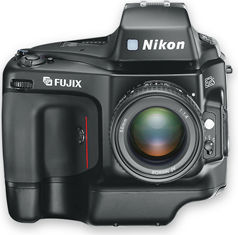 |
|
It was rather late* that when Companies like NIKON began to realize the needs of photojournalists/publishers that got started in looking digital photography due to reasons above that created such a demand for such tools in professional photography that prompted Nikon to take an initial effort in developing their fist digital SLRs.
The first known Nikon body of Nikon camera, Nikon Video Still Camera Model 1 was designed for digital imaging (a floppy disk based, black-and-white-only digital imaging camera) was showcased at Photokina '86. The displayed unit shared a common Nikon F-lens bayonet, and a Nikkor 6 mm f/1.6 lense has never went into production and remained only a prototype.
 |
* The more known unit, Nikon QV-1000C Still Video Camara, which was more popularly referred as Nikon's first non-film-based SLR also uses similar concept of the previous mentioned Model 1, uses a "digital" medium (via a 2 " micro-floppy magnetic disks - similar to the configuration used in the Model 1), which can stored approx. 50 images). It offers basic features like any of today;s digital medium camera such as cropping and can remit via telephone lines to designated receving end.The camera also offers standard AE control modes as well as it was also TTL flash enabled camera. The camera uses a few dedicated lenses but conventional 35mm SLR lenses can also be used via an adapter. Source: Nikon website. |
* Also check section on the Kodak-modified Nikon F3 DSU unit to understand early version of Digital imaging products.
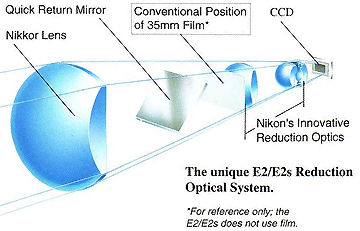 |
Digital Technology in the first Digital SLR under Nikon label: However, as Kodak was still committed in choosing Nikon bodies for their development of SLR photography during the early days, Nikon eventual effort has never seriously been promoting the new medium aggressively. But behind all these happenings at the front of the curtain, Nikon quietly teamed up with their countryman, Fuji Photo Films Co. Ltd. in developing their first digital SLR body which used Nikon system as te frameworks. The partnership made a lot of business sense as both can share the initial high cost in research and development for such a new untested product in the highly competitive market place. So, the birth of the E2/E2s was not entirely coincidental as Nikon mentioned in their literature "... E2/E2s were co-developed with Fuji Photo Film Co., Ltd. All names of companies and products are trademarks or registered trademarks of their respective holders. Specifications and equipment based on November 1995..." and it explained partly why the camera also bear a "Fujix" name tag on top of the hand grip section. |
 |
The above illustration outline Nikon's approach: An on-Board Low-Pass CCD Filter Captures Fine Gradations Nikon's Reduction Optics Technology assured compositional accuracy. The low-pass filter located in front of the CCD, combined efficiently with infrared and crystal filters, virtually eliminated RGB mode With colour aliasing, it minimizes post-processing with filtering software. The Fuji DS-505(A)/515(A) may have carried the same technical configuration |
Today, for instant image availability, digital images are the preferred format. Although the early E2 /E2s resolution was still far from calling it a perfect tool but since requirement in photojournalism and news media are comparatively lower than desktop publishing, they were still considered to be a good choice - bearing in mind how much does the Kodak sells their digital models those days. Personally, I would think Nikon/Fuji should put parallel effort in also developing digital film backs for conventional SLRs. Nikon provided TWO models - E2 or E2s --all depends on framing rate. The E2 is capable of continuous shooting at rates up to one frame-per-second (fps). The E2s has a powerful internal memory, so it is capable of shooting three fps for up to seven consecutive pictures (after a brief seven-second pause (writing time onto card), you can shoot again). That makes the major difference between the two models. |
Anyway, as the camera is almost designed from ground up in its handling to work like a conventional SLR body, the all-automated digi-cam E2/E2s can help you forget about complicated electronics. In fact, making acceptable high-resolution electronic images with the E2/E2s is as easy as using a standard film-format Nikon-with the same selection of Nikkor optics, Speedlights and other Nikon accessories. And if you're already familiar with professional Nikon SLR features, such as Matrix Metering and Balanced Fill-Flash, so, in many ways, for those in need of such medium =in their field works, the introduction of the camera could provide a significant advantage those days as you have gained a giant step ahead over the others in maneuver the images on the spot, because the E2/E2s gives you those and a whole lot more. The Nikon E2 and E2s incorporate a 2/3 inch, 1.3 million pixel CCD imaging sensor that captures full-color images. The days, it was a significant effort as it established a standard for semi-high-resolution digital imaging in an affordable package as compared to Kodak's more pricey various offerings. The main advantage is, images can be instantly viewed on a computer screen or TV monitor, or output through a compatible Nikon color printer, the results can be regarded as acceptably sharp, clear, high-resolution image with balanced color for immediate output in media based publishing works.
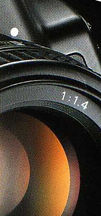 |
|
Another advantage is, as the camera employs a conventional reflex-SLR design, EXCEPT for the REDUCTION RATIO, whatever you took is what you saw inside the viewfinder. You can capture the wide view you've been looking for, from remarkable wideangle optics like the AF Zoom-Nikkor 20-35mm f/2.8D (introduced during the mid-90) to the super telephoto like AF-1 Nikkor 300mm f/2.8D IF-ED which delivers relatively-fast autofocus as conventional Nikon AF SLRs. It's all the result of Nikon's outstanding Reduction-Optics Technology, which compresses the full 35mm lens image into the smaller 2/3 inch CCD format. |
Nikon system compatibility Whatever it is, to many Nikon faithful, the biggest advantage is, with the E2/E2s, you can share and tag into the Nikon System. In fact, except for its oversized dimension, it possesses familiar Nikon handling ease - typical hallmark of Nikon SLRs. From the wide selection of compatible Nikkor optics, to the familiar Command Dial and user-friendly LCD, the E2/E2s can be a very good supplement camera for digital shooting.
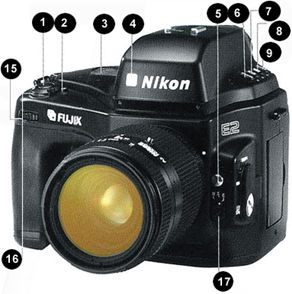 |
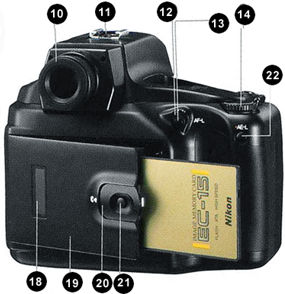 |
1. Shutter release button |
| 13. AF-L (Auto Focus Lock) button 14. Command input control dial 15. Main dial (L, S, C, SD, PB) 16. Aperture dial 17. Focus mode selector |
18. Image Memory Card confirmation
window 19. Camera back (incorporating the Image Memory Card slot) 20. image memory card (PC cud) eject knob 21. Eject knob lock-release button 22. AE-L (Auto Exposure Lock) button |
Everything likes a film-based Nikon - Except it is a Digital Cam.
Various Exposure Controls Options:
The camera operates and behaved like any other Nikon introduced at the time of its
introduction as its various exposure and metering options provide you in control
of just about any lighting condition with a full set of Nikon light Meters inside
the camera:
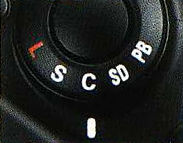 |
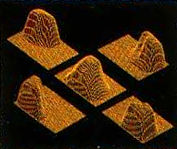 |
It incorporates the Matrix (5-segments) meter, Center-Weighted Meter with 70/30 balance and Spot Meter that reads approx. 2.5% of the picture areas and can be used with either camera's Program, Aperture-Priority, Shutter-Priority and Manual exposure controls. When used with Nikon Speedlights such as the SB-26, the E2 and E2s offer a broad spectrum of creative flash options from Matrix Balanced Fill-Flash to Rear-Curtain Sync and Wireless Multiple Flash operation. |
With their built-in Reduction Optics
and Aperture Control, the Nikon E2 and E2s offer a maximum aperture of f/6.7 and
a minimum aperture of f/38. Choose from ISO equivalencies of 880 or 1600 and be ready
to shoot under the most demanding lighting conditions. * An ISO setting of 1600
at f/6.7 is equivalent to ISO 400 at approx. f/3.3. The camera also incorporates
a Command Dial control design - something that the newer Nikon SLRs employed during
that time and a larger LCD indicators that locate both at the camera top panel and
viewfinder which helps to put you in full control. And if you already own w or use
a Nikon 35mm System, you'll be amazed at how many lenses, Speedlights and other key
accessories fit your E2/E2s. For wireless light-activated remote control, you can
also make use of the Nikon Modulite units. The main selling point though, was it
is a damn good supplementary model to assist you while you shoot conventional film
format and decide upon whether another "spare" image should be in digital
for faster deliveries.
High-Capacity PCMCIA Data Storage Cards for convenient, efficient operation The
E2/E2s stores each digital image on a standard, reusable PCMCIA ATA Type I/H memory
card. Images can be stored in full data format or compressed for efficiency. Just
slip the card out of the camera and insert a compatible Nikon Card Reader connected
to your personal computer (PC or Macintosh). and you are ready to view and manage
your images.
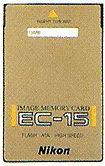 |
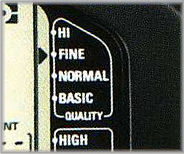 |
A wide range of popular optional software programs are available to process your image files. Leave it to the production people, or work the images yourself. It's both challenging and fun at the same time. Although this early model was far from optimum in its image resolution as compared to many today;s Digicam but those days, it was a real treat. |
Three image compression modes to fit your needs Choose from three ]PEG compression modes-Basic, Normal, and Fine-or uncompressed TIFF for the highest quality of all. The number of images you can store in a single PCMCIA card depends on the compression mode you choose and the card's memory capacity. A standard 15MB PC card EC-15, for example, held about 84 images in the BASIC mode.
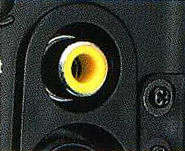 |
Analog video output and color control-see the picture on the spot The E2/E2s also comes with an analog video output terminal (NTSC or PAL), for easy connection to any TV monitor. An external portable TV monitor with video-in terminal could also be used to review images on screen without having to connect to a computer White balance can be controlled automatically or manually, to ensure perfectly balanced color images. Somehow, the partnership with Fuji Film has benefited Nikon in its software - in particular the colour management and white balance, Nikon still holds the advantage in these areas even today. |
 |
Nikon E2 Browser software: Nikon E2 Browser offers the following features: |
The software includes advanced features such as thumbnail display, individual image data, data deletion and image conversion capabilities. Images can also be transferred to applications handling JPEG and PICT files, such as Adobe Photoshop.
Possible Applications:
Portrait, Studio and LD copy The Nikon E2/E2s offers the perfect package for
Portrait photography. Just compose, shoot and instantly show your client the picture
via the camera's Analog Video Output and any compatible TV. It's the ideal choice
for ID systems, too.
Newspapers and journalism Shoot and deliver. Very appealing to photographers
that works in news reporting or general usage such as not so demanding works like
real-estate section etc. But the key is, you can meet deadlines faster than ever
and scoop the competition. Nikon's PCMCIA ATA Type I/II compact data storage cards
offer easy compatibility with personal computers. Another good applications is for
catalog production, as quick picture turnaround can make all the difference in meeting
deadlines. As you get your images immediately, view them immediately, and get them
into the page layout immediately - which simplifies the work flow from shooting to
eventual production.
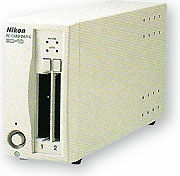 |
 |
Medical, Scientific, Industrial, Forensic In the lab or on the production site, digital imaging can add a vital new dimension to the work, enhancing ability to maintain detailed records and produce materials for publication |
| Card slot | 2 slots |
|
| Interface | SCSI-2 (Full pitch 50P x 2) | |
| Data transfer rate | Approx. 3 MB/sec | |
| Dimensions | 60 (W) x 123 (H) x 271 (D) mm | |
| Weight | Approx. 1.2 kg Note: The CR-500 includes driver software for Macintosh® and Windows®. | |
Useful
Downloads:
PDF Instruction Manual (6.9MB) for Nikon Capture 2.0 | PDF Instruction
Manual (12.2MB) for
Nikon Capture 3.0
PDF Instruction Manual (11.9MB) for Nikon Capture 4.0 | PDF Instruction
Manual (6.0MB)
for Nikon Capture 4.1
| NEXT | Technical Specification for the original Nikon E2/E2s Digital Still SLR camera.
| Back | Index Page of Digital Nikon SLR cameras
| Back |
Main
Index Page
of Pictorial History of Nikon SLR camera
E-Series:
Nikon
E2/E2s | Nikon
E2N/E2Ns |
Nikon
E3/E3s
D-Series: Nikon
D1 | Nikon
D1H / Nikon D1x
| Nikon
D100 | Nikon
D70 | Nikon
D2H | Nikon
D2X
Related Info:
Fuji Film's FinePix
S1 Pro| FinePix
S2 Pro | FinePix S3 Pro
Kodak DCS-Series SLR models: Main Index Page (7 Parts)
The
Rangefinder
|| The
Nikonos ||
Compact Cameras
SLRs -1959/1979 |
1980/1990 | 1991/1999 | y2k/2003 | 2004 ~
The
Eyes of Nikon:-
Nippon
Kogaku KK Rangefinder
RF-Nikkor
lenses:-
Main Index Page
Nikon
Auto
Focus
Nikkor lenses:- Main Index Page
Nikon
Manual
Focus
Nikkor lenses-
Main Index Page
Fisheye-Nikkor Lenses - Circular | Full Frame |
Ultrawides Lenses - 13mm15mm18mm20mm | Wideangle Lenses - 24mm28mm35mm |
Standard Lenses - 45mm 50mm 58mm | Telephoto
Lenses - 85mm105mm135mm180mm & 200mm |
Super-Telephoto
Lenses - 300mm 400mm 500mm 600mm 800mm 1200mm |
Special
Application lenses:
Micro-Nikkor Lenses - 50mm~55mm -60mm 85mm -105mm 200mm Micro-Zoom 70-180mm
Perspective
Control
(PC) - 28mm 35mm
PC-Micro
85mm
Dedicated
Lenses for Nikon F3AF: AF 80mm f/2.8 | AF 200mm f/3.5 EDIF
Depth
of Field Control (DC): 105mm 135mm
Medical
Nikkor: 120mm 200mm
Reflex-Nikkor Lenses - 500mm 1000mm 2000mm
Others:
Noct Nikkor |
OP-Nikkor | UV Nikkor 55mm 105mm |
Focusing Units | Bellows-Nikkor 105mm 135mm
Nikon
Series E Lenses: 28mm35mm50mm100mm135mm |
E-Series Zoom lenses: 36~72mm75~150mm70~210mm
MF Zoom-Nikkor
Lenses:
25~50mm | 28~45mm | 28~50mm | 28~85mm | 35~70mm | 36~72mm E | 35~85mm | 35~105mm | 35~135mm |
35~200mm | 43~86mm | 50~135mm | 50~300mm | 70~210mm E | 75~150mm E | 80~200mm | 85~250mm |
100~300mm | 180~600mm | 200~400mm | 200~600mm | 360~1200mm | 1200~1700mm
Tele-Converters: TC-1 | TC-2 | TC-200 | TC-201 | TC-300 | TC-301 | TC-14 | TC-14A | TC-14B | TC-14C | TC-14E |
TC-16
|
TC-16A | TC-20E
![]()
Nikon F
| Nikon F2 |
Nikon F3 |
Nikon F4 |
Nikon F5 |
Nikon F6 |
Nikkormat / Nikomat |
Nikon FM
| Nikon FE/ FA | Nikon EM/FG/FG20 | Nikon Digital SLRs | Nikon - Other models
MIR Supports for Photographic Community: Various Message Boards/Community
Forums
Nikon
F-series|
Nikon
F2-series|
Nikon
F3-series|
Nikon F4-series| Nikon
F5-series|Nikkormat/Nikomat-series
Nikon FM-series|Nikon
FE-series|Nikon
FA|Nikon
Digital
SLR
series|Various
Nikon
Models|Nikkor
Optic
-shared
Others:- Free Trade Zone - Photography| Free Trade Zone - Business Community |Free To Zouk - Photographic Community
Apple's Mac Public Community Message Board | Windows based PC &
Apple/Mac
Public Community Trade Exchange Centre
Recommended links to understand
more technical details related to the Nikkor F-mount and production Serial Number:
http://rick_oleson.tripod.com/index-153.html by: my friend, Rick Oleson
http://www.zi.ku.dk/personal/lhhansen/photo/fmount.htm by: Hansen, Lars Holst
http://www.mir.com.my/rb/photography/hardwares/nikonfmount/lens2.htm
http://www.photosynthesis.co.nz/nikon/serialno.html
About
this photographic
site.
Home - Photography
In Malaysia
![]()
Copyright
© 1998. leofoo ®. MIR Web Development Team.
[Left Brain][Right
brain][Home-MIR]
[Invention][Art & Design][Clubs]
[Portfolios][On assignments]
[Trading
room][Knowledge
& Resources]
[Free-trade-zone][Thoughts & opinions][Links]

